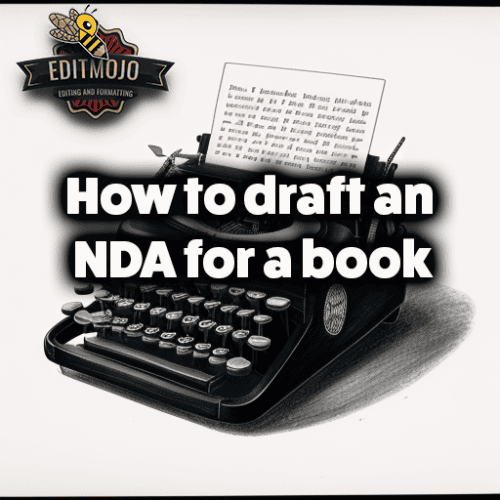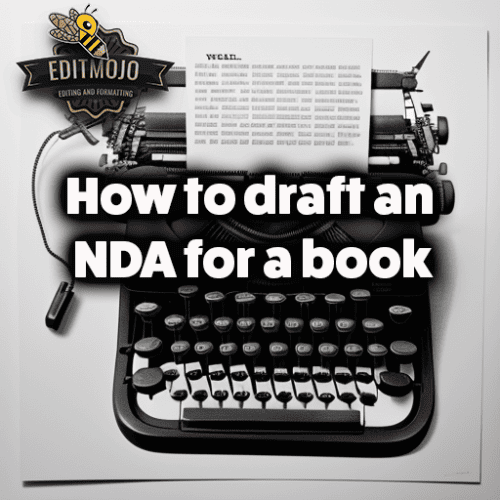How to draft an NDA for a book
How to draft an NDA for a book. As creators, we have a natural instinct to protect our work, particularly when it comes to something as deeply personal and time-consuming as writing a book. One tool for this protection is the Non-Disclosure Agreement (NDA). This guide will take you through the steps needed to draft a robust NDA, highlighting unique considerations for authors and publishers.
Key Takeaways
| Point | Key Takeaway |
|---|---|
| Understanding NDAs | An NDA is a legally binding contract that prevents sharing of confidential information. In the literary world, it protects plot details, character developments, and innovative concepts. |
| Types of NDAs | NDAs can be unilateral (one party sharing information) or mutual (two or more parties sharing information). |
| Drafting an NDA | Drafting an NDA involves identifying the parties, defining confidential information, specifying the terms and consequences of breaches, and concluding the agreement with signatures. |
| Unique Aspects of an NDA for a Book | Unique aspects can include protecting the essence of creativity, including specific literary-related clauses like non-compete agreements, and considering the lifecycle of the book and future works. |
| Legal and Ethical Implications | Legal advice should be sought before drafting or signing an NDA. Ethical considerations include respecting the rights of others and not stifling creativity or legitimate criticism. |
Understanding the Basics of an NDA
An NDA, also known as a confidentiality agreement, is a legally binding contract that prevents one party from sharing specified information with others. In the context of book writing and publishing, an NDA can be used to ensure that your unpublished work remains confidential until you decide it’s time for it to see the light of day.
NDAs can be classified into two types: unilateral and mutual. A unilateral NDA is used when only one party is sharing confidential information, whereas a mutual NDA involves two or more parties exchanging confidential information. In the literary world, a unilateral NDA might be used when an author shares their manuscript with an editor, while a mutual NDA could be employed during a collaborative writing project.
Identifying the Need for an NDA in Book Publishing
In book publishing, NDAs are often used when sharing a manuscript with beta readers, editors, proofreaders, illustrators, or literary agents. Their purpose is to ensure that the unique elements of your work—be they plot twists, character developments, or innovative concepts—remain under wraps until publication.
For instance, when J.K. Rowling was drafting the “Harry Potter” series, she kept the plot details secret using NDAs, which helped her maintain the suspense and anticipation among readers. Protecting your intellectual property rights in such a manner can be critical to the success of your book.
Steps to Draft an NDA for a Book
Drafting an NDA requires precision and attention to detail. Here’s a step-by-step guide:
Identifying the Parties Involved
Clearly list who the NDA is between – the “disclosing party” (usually the author) and the “receiving party” (such as the editor or literary agent). It is important to use the legal names of the parties involved.

Defining Confidential Information
The heart of the NDA is defining what information is considered confidential. In the context of a book, this could include the manuscript, plot details, character sketches, marketing strategies, and even your authorial pseudonym if you choose to use one.
Terms of the NDA
Specify the terms of the agreement, including its duration (how long the NDA will last) and the permissible uses of the confidential information. It’s essential to consider the lifecycle of your book and potential future works that may be connected to it.
Clauses about Breach and Consequences
Outline the consequences if a breach occurs. This could include monetary damages or even a court injunction. The aim here is not to instigate a court case, but rather to deter any thought of violating the agreement.
Concluding the Agreement
The NDA should conclude with a place for signatures and dates, signifying the acceptance of the terms by both parties.

The Unique Aspects of an NDA for a Book
Drafting an NDA for a book comes with its own unique considerations. The scope of confidentiality for an unpublished manuscript is broad—it’s not just the words on the page, but the very essence of your creativity that you’re seeking to protect.
You might need to include specific clauses in your NDA related to literary works. For example, you could include a non-compete clause to prevent a ghostwriter from publishing a
similar book.
The Legal Side of NDAs
NDAs, like any other legal document, come with their own set of legal considerations. It’s always wise to seek legal advice before drafting or signing an NDA to ensure that your rights are adequately protected.
If you’re dealing with parties from different countries, you might need to consider the implications of international laws and regulations. For instance, the General Data Protection Regulation (GDPR) in the European Union has specific requirements for information privacy that might impact what you can include in your NDA.
Ethical Implications and NDAs (How to draft an NDA for a book)
While NDAs are critical tools for protecting your work, it’s essential to balance this need with ethical considerations. NDAs should not be used to prevent legitimate criticism, stifle creativity, or hide unethical behavior.
In the literary world, the right to freedom of expression and the right to information are highly valued. It’s vital to strike a balance that respects these rights while still protecting your intellectual property.
Navigating the Consequences of NDA Breaches
Despite your best efforts, there might come a time when an NDA is breached. If this happens, it’s crucial to know what steps to take. Possible legal repercussions of violating an NDA include a court injunction to prevent further disclosure and monetary damages to compensate for any loss.
In some cases, it might be preferable to resolve disputes through arbitration rather than court proceedings, as it can be faster and less costly. Including an arbitration clause in your NDA is one way to ensure this happens.

Conclusion (How to draft an NDA for a book)
Drafting an NDA for your book can be a daunting task, but it’s a necessary one. By taking the time to understand the process and tailor the agreement to your needs, you can ensure that your hard work remains confidential until you’re ready to share it with the world.
Remember, an NDA is a legally binding agreement. Always seek legal advice before drafting or signing an NDA. Online resources like LawDepot or Rocket Lawyer can help you create a basic NDA, but nothing can replace personalized legal advice.
Finally, remember that while protecting your work is vital, it should not come at the expense of ethical considerations. A good NDA protects your work without infringing upon the rights of others.
Be bold, be creative, and protect your masterpiece wisely!
Sample CONFIDENTIALITY AND NON-DISCLOSURE AGREEMENT
This Agreement, made and entered into as of ______, 20, by and between _______________________, hereinafter referred to as the “Author,” and _______________________, hereinafter referred to as the “Recipient”.
WHEREAS, the Author is the creator and owner of a literary work currently titled _______________________, hereinafter referred to as the “Work”;
WHEREAS, the Recipient may be exposed to certain confidential information related to the Work;
NOW, THEREFORE, in consideration of the mutual covenants and conditions herein, the parties hereto agree as follows:
1. DEFINITION OF CONFIDENTIAL INFORMATION: As used in this Agreement, “Confidential Information” means any and all non-public information, including, but not limited to, plot details, character details, and other specifics related to the Work.
2. NON-DISCLOSURE AND NON-USE OBLIGATIONS: Recipient agrees to maintain in confidence the Confidential Information and to not use such Confidential Information except as expressly permitted herein. Recipient shall not disclose, publish, or disseminate Confidential Information to anyone other than individuals who are directly participating in the review, analysis, or other consideration of the Work and who are also bound by a confidentiality agreement.
3. TERM: This Agreement shall govern all communications between the parties that are made from the Effective Date until the date that the Author releases the Work publicly.
4. REMEDIES: Recipient acknowledges that the disclosure or use of the Confidential Information in violation of this Agreement could cause the Author irreparable harm for which monetary damages may be difficult to ascertain or an inadequate remedy. Therefore, the Author will have the right to seek immediate injunctive relief to enforce obligations under this Agreement in addition to any other rights and remedies it may have.
5. GOVERNING LAW: This Agreement shall be governed by and construed in accordance with the laws of the state of _________.
6. ENTIRE AGREEMENT: This Agreement constitutes the entire understanding between the parties hereto with respect to the subject matter hereof, and all prior agreements, representations, and statements with respect to such subject matter are superseded hereby.
IN WITNESS WHEREOF, the parties have executed this Agreement as of the date first above written.
(Author)
(Recipient)
Top Five Questions and Answers
| Question | Answer |
|---|---|
| What is a Non-Disclosure Agreement (NDA)? | An NDA is a legally binding contract that prevents one party from sharing certain information with others. |
| When should an NDA be used in book publishing? | An NDA should be used when sharing a manuscript or other confidential information with parties such as editors, literary agents, proofreaders, illustrators, or beta readers. |
| What are some unique considerations when drafting an NDA for a book? | Unique considerations include the broad scope of confidentiality for an unpublished manuscript and the inclusion of specific clauses related to literary works. |
| What are the legal implications of an NDA? | Legal implications can include court injunctions, monetary damages, and the need to consider international laws and regulations, such as the GDPR in the European Union. |
| What are some ethical considerations when using an NDA in book publishing? | Ethical considerations include ensuring that the NDA does not prevent legitimate criticism, stifle creativity, or infract upon the rights of others. |
